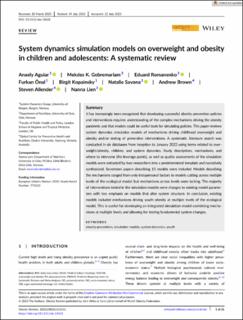| dc.contributor.author | Aguiar, Anaely | |
| dc.contributor.author | Gebremariam, Mekdes Kebede | |
| dc.contributor.author | Romanenko, Eduard | |
| dc.contributor.author | Onal, Furkan | |
| dc.contributor.author | Kopainsky, Birgit | |
| dc.contributor.author | Savona, Natalie | |
| dc.contributor.author | Brown, Andrew | |
| dc.contributor.author | Allender, Steven | |
| dc.contributor.author | Lien, Nanna | |
| dc.date.accessioned | 2023-10-03T07:06:57Z | |
| dc.date.available | 2023-10-03T07:06:57Z | |
| dc.date.created | 2023-09-27T14:53:31Z | |
| dc.date.issued | 2023 | |
| dc.identifier.issn | 1467-7881 | |
| dc.identifier.uri | https://hdl.handle.net/11250/3093633 | |
| dc.description.abstract | It has increasingly been recognized that developing successful obesity prevention policies and interventions requires understanding of the complex mechanisms driving the obesity pandemic and that models could be useful tools for simulating policies. This paper reviews system dynamics simulation models of mechanisms driving childhood overweight and obesity and/or testing of preventive interventions. A systematic literature search was conducted in six databases from inception to January 2023 using terms related to overweight/obesity, children, and system dynamics. Study descriptives, mechanisms, and where to intervene (the leverage points), as well as quality assessments of the simulation models were extracted by two researchers into a predetermined template and narratively synthesized. Seventeen papers describing 15 models were included. Models describing the mechanisms ranged from only intrapersonal factors to models cutting across multiple levels of the ecological model, but mechanisms across levels were lacking. The majority of interventions tested in the simulation models were changes to existing model parameters with less emphasis on models that alter system structure. In conclusion, existing models included mechanisms driving youth obesity at multiple levels of the ecological model. This is useful for developing an integrated simulation model combining mechanisms at multiple levels and allowing for testing fundamental system changes. | en_US |
| dc.language.iso | eng | en_US |
| dc.publisher | Wiley | en_US |
| dc.rights | Navngivelse-Ikkekommersiell 4.0 Internasjonal | * |
| dc.rights.uri | http://creativecommons.org/licenses/by-nc/4.0/deed.no | * |
| dc.title | System dynamics simulation models on overweight and obesity in children and adolescents: A systematic review | en_US |
| dc.type | Journal article | en_US |
| dc.type | Peer reviewed | en_US |
| dc.description.version | publishedVersion | en_US |
| dc.rights.holder | Copyright 2023 the authors | en_US |
| dc.source.articlenumber | e13632 | en_US |
| cristin.ispublished | true | |
| cristin.fulltext | original | |
| cristin.qualitycode | 1 | |
| dc.identifier.doi | https://doi.org/10.1111/obr.13632 | |
| dc.identifier.cristin | 2179523 | |
| dc.source.journal | Obesity Reviews | en_US |
| dc.identifier.citation | Obesity Reviews. 2023, 24 (S2), e13632. | en_US |
| dc.source.volume | 24 | en_US |
| dc.source.issue | S2 | en_US |

